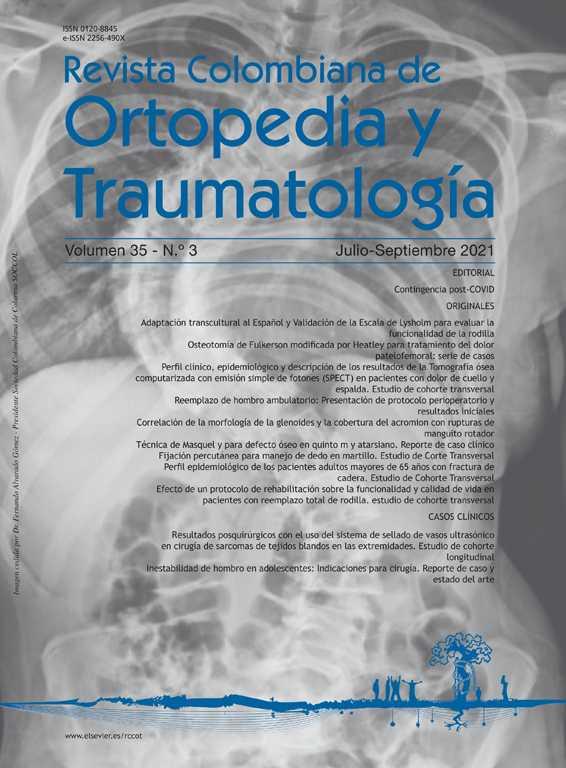Correlation of glenoid morphology and acromial coverage with rotator cuff tears
DOI:
https://doi.org/10.1016/j.rccot.2021.09.001Keywords:
Glenoid morphology, Acromiun morphology, Rotator cuff tearsAbstract
Background: The purpose of this study was to determine if there is a difference between the critical shoulder angle measured by MRI in patients with rotator cuff tear and healthy patients, also to evaluate the intraobserver reliability in this measure. Other variables were included as well, lateral acromial extension, acromial height, glenoid version, glenoid inclination and lateral acromial angle.
Materials and methods: Two groups were evaluated, the control group consisted in a total of 16 patients and the group with rotator cuff tear consisted of 15 patients. The critical shoulder angle, glenoid inclination, glenoid version, acromial height, lateral acromial extension and lateral acromial angle were measured on MRI. A student T test was used for comparison of means between both groups, Pearson correlation coefficient was used for evaluating the association between variables. The intraobserver reliability was evaluated using the intraclass correlation coefficient.
Results: A result of 0.961 was obtained for the intraobserver reliability using the intraclass correlation coefficient for the critical shoulder angle. For the comparison of means of the critical shoulder angle in the control group and the rotator cuff tear group a result of 32.3◦ (3.6) vs. 35.01◦ (2.4) was obtained with a statistically significant difference of p = 0.02. Likewise, statistically significant differences were obtained in the glenoid inclination and glenoid version in both groups (81.56◦ SD 4.04 vs 77.11◦ SD 3.84; p = 0.004) and (−4.47◦ SD 4.56 vs −1.58◦ SD 3.94; p = 0.04).
Discussion: Critical shoulder angle measured by MRI is statistically significant different in control group and in rotator cuff tear group.
Evidence Level: III.
Downloads
References
Bigliani LU, Morrison DS, April EW. The morphology of the acromion and its relationship to rotator cuff tears. Orthop Trans. 1986;10:228.
Saygi B, Karahan N, Karakus O, Demir A, Ozkan O, Soylu-Boy F. Analysis of glenohumeral morphological factors for anterior shoulder instability and rotator cuff tear by magnetic resonance imaging. Journal of Orthopaedic Surgery. 2018;26, 230949901876810.
Nyffeler R, Werner C, Sukthankar A, Schmid M, Gerber C. Association of a large lateral extension of the acromion with rotator cuff tears. The journal of Bone and Joint Surgery-American volume. 2006;88:800-5.
Li X, Olszewski N, Abdul-Rassoul H, Curry E, Galvin J, Eichinger J. Relationship Between the Critical Shoulder Angle and Shoulder Disease. JBJS Reviews. 2018;6:e1.
Moor B, Bouaicha S, Rothenfluh D, Sukthankar A, Gerber C. Is there an association between the individual anatomy of the scapula and the development of rotator cuff tears or osteoarthritis of the glenohumeral joint? The Bone & Joint Journal. 2013;95-B:935-41.
Spiegl U, Horan M, Smith S, Ho C, Millett P. The critical shoulder angle is associated with rotator cuff tears and shoulder osteoarthritis and is better assessed with radiographs over MRI. Knee Surgery, Sports Traumatology. Arthroscopy. 2015;24:2244-51.
Beeler S, Hasler A, Götschi T, Meyer D, Gerber C. Critical shoulder angle: Acromial coverage is more relevant than glenoid inclination. Journal of Orthopaedic Research®. 2019;37:205-10.
Banas M, Miller R, Totterman S. Relationship between the lateral acromion angle and rotator cuff disease. Journal of Shoulder and Elbow Surgery. 1995;4:454-61.
Daggett M, Werner B, Collin P, Gauci M, Chaoui J, Walch G. Correlation between glenoid inclination and critical shoulder angle: a radiographic and computed tomography study. Journal of Shoulder and Elbow Surgery. 2015;24: 1948-53.
Kirsch J, Nathani A, Robbins C, Gagnier J, Bedi A, Miller B. Is There an Association Between the ‘‘Critical Shoulder Angle’’ and Clinical Outcome after Rotator Cuff Repair? Orthopaedic Journal of Sports Medicine. 2016;4 7 suppl4, 2325967116S0019.
Garcia G, Liu J, Degen R, Johnson C, Wong A, Dines D, et al. Higher critical shoulder angle increases the risk of retear after rotator cuff repair. Journal of Shoulder and Elbow Surgery. 2017;26:241-5.
Song J, Yun S, Song Y, Lee S. High performance of critical shoulder angle for diagnosing rotator cuff tears on radiographs. Knee Surgery, Sports Traumatology, Arthroscopy. 2018;27:289-98.
Suter T, Gerber Popp A, Zhang Y, Zhang C, Tashjian R, Henninger H. The influence of radiographic viewing perspective and demographics on the critical shoulder angle. Journal of Shoulder and Elbow Surgery. 2015;24:e149-58.
Tétreault P, Krueger A, Zurakowski D, Gerber C. Glenoid version and rotator cuff tears. Journal of Orthopaedic Research. 2004;22:202-7.
Kandemir U, Allaire R, Jolly J, Debski R, McMahon P. The relationship between the orientation of the glenoid and tears of the rotator cuff. The Journal of Bone and Joint Surgery British volume. 2006;88-B:1105-9.
Dogan M, Cay N, Tosun O, Karaoglanoglu M, Bozkurt M. Glenoid axis is not related with rotator cuff tears-a magnetic resonance imaging comparative study. International Orthopaedics. 2011;36:595-8.
Tokgoz N, Kanatli U, Voyvoda N, Gultekin S, Bolukbasi S, Tali E. The relationship of glenoid and humeral version with supraspinatus tendon tears. Skeletal Radiology. 2007;36:509-14.





